How to use customer feedback for E-commerce growth Imagine turning your customer feedback into a goldmine of information that could catapult your e-commerce business to new heights. It’s not just a fantasy; using customer feedback effectively can help you understand your audience better, refine your product offerings, and ultimately boost sales. In this post, we’re going to explore practical strategies to leverage how to use customer feedback for e-commerce growth. Dive in to uncover the steps you need to take to transform criticism into opportunity.
How to Use Customer Feedback for E-commerce Growth
Why Customer Feedback is Crucial for E-commerce
In the bustling world of e-commerce, customer feedback acts as a bridge between you and your customers. It’s more than just knowing if they liked or disliked a product; it’s a direct line to understanding their wants, needs, and pain points. But why is this so crucial? Simply put, feedback provides actionable insights that can power your business strategy and product enhancements.
Improving Products and Services
Your customers are the most valuable source of honest opinions on your products. Identify common themes in feedback to spot product features that are either the most beloved or most criticized. From there, you can make informed decisions about what improvements or changes need to be made, turning mediocrity into excellence. Consider tools like Trustpilot to collect & analyze feedback.
Building Customer Relationships
Listening to your customers’ voices makes them feel valued and heard, which can significantly enhance their loyalty to your brand. When customers see that their opinions trigger real changes, they feel a bond with your company. This emotional connection fosters long-term relationships, encouraging repeat purchases and brand advocacy.
How to Collect Customer Feedback Effectively
So, how do you capture this vital feedback effectively? Let’s break it down:
- Online Surveys: Quick and versatile, surveys are a traditional yet powerful method. Tools like SurveyMonkey or Google Forms let you create custom surveys that pinpoint the feedback you need.
- Email Follow-ups: After a purchase, send a follow-up email seeking feedback on the overall customer experience. Personalized emails are over likely to get responses.
- Social Media Monitoring: Platforms like Twitter and Instagram serve as real-time feedback channels. Monitor them for mentions of your brand and engage with users to get their opinions.
Analyzing Customer Feedback
Collecting feedback is just the beginning. The real magic lies in analysis. Here’s how you can decode the feedback to bring about actionable change:
Identify Patterns
Group similar feedback points together to identify broader trends. For example, if many customers mention late deliveries, you may need to revisit your shipping processes or partners.
Quantitative vs. Qualitative Feedback
Quantitative data, such as rating scales, provides an overview of customer satisfaction levels. Qualitative feedback, like open-ended comments, gives deeper insights into customers’ thoughts and emotions. Both are essential for creating a full picture of customer sentiment.
Prioritize Actionable Feedback
While all feedback is valuable, focus on what’s actionable. If several customers suggest a feature that aligns with your business goals, prioritize its development. This targeted action shows customers that you are attentive and responsive to their needs.
Implementing Changes Based on Feedback
Once you gather & analyze feedback, the next step is implementation. How do you go about transforming insights into tangible changes?
- Test and Iterate: Make small changes initially, allowing you to test their impact before a full-scale rollout. This helps in minimizing risk while maintaining flexibility.
- Communicate Changes: Transparency is key! Let your customers know what change you’ve implemented based on their feedback. This can be done through newsletters, blog post, or social media announcements.
- Measure Success: After implementing changes, measure their impact. Use customer satisfaction scores, sales data, or other relevant metrics to evaluate success.
Boosting E-commerce Growth with Feedback
Ultimately, leveraging customer feedback should do more than just enhance products or services; it should also help grow your business. Here’s how feedback can directly contribute to e-commerce growth:
Boosting Customer Retention
A satisfied customer is a returning customer. By addressing their concerns and enhancing their shopping experience, you increase the likelihood of repeat business, reducing the churn rate and boosting revenue.
Gaining New Customers
Happy customers are the best advertisements. User-generated content and positive reviews act like digital word-of-mouth, attracting new customers to your store. Encourage satisfied customer to share their experiences over social platforms.
Informing Marketing Strategies
How to use customer feedback for E-commerce growth offers valuable insights into consumer behavior and preferences, helping shape marketing strategies. Tailor your advertising campaigns around what your customers value most to attract a larger audience.
By understanding and harnessing the power of customer feedback, your e-commerce store can evolve and thrive in the competitive digital marketplace. Put these strategies into action, and watch your business grow as you connect more deeply with your customer base.


